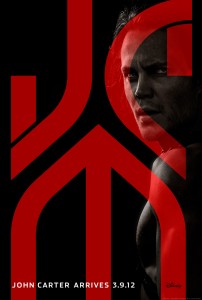 Disney has released the first trailer for John Carter, the big screen adaptation of Edgar Rice Burroughs’ classic sci-fi novel series. Based on the first entry entitled ‘A Princess of Mars’ published back in 1917, the story introduced fans to the world of Barsoom, a romantic vision of a dying Mars. The classic series inspired a generation of authors, artists and filmmakers, including the likes of George Lucas and James Cameron, who have been drawn to the stories of ‘outsider heroes and alien princesses‘. Many filmmakers had attempted to adapt the material over the years and walked away, until former Pixar animator and director Andrew Stanton (Wall-E) took over the project, having been a fan of the material.
Disney has released the first trailer for John Carter, the big screen adaptation of Edgar Rice Burroughs’ classic sci-fi novel series. Based on the first entry entitled ‘A Princess of Mars’ published back in 1917, the story introduced fans to the world of Barsoom, a romantic vision of a dying Mars. The classic series inspired a generation of authors, artists and filmmakers, including the likes of George Lucas and James Cameron, who have been drawn to the stories of ‘outsider heroes and alien princesses‘. Many filmmakers had attempted to adapt the material over the years and walked away, until former Pixar animator and director Andrew Stanton (Wall-E) took over the project, having been a fan of the material.
The story sees former military captain John Carter, played by Taylor Kitsch – transported to Mars where he becomes embroiled in a conflict between the inhabitants of the planet, including Tars Tarkas (Willem Dafoe) and Princess Dejah Thoris (Lynn Collins). Originally the film went under the extended title of ‘John Carter of Mars’, though focus groups figured a more simplified title would be better – the inclusion of Mars was way cooler – but since we know where it takes place, it shouldn’t make that much difference.
The film was shot in Utah last year with some re shoots taking place in L.A this April, the film is a CGI heavy piece so it’s been in the visual effects animation process for the last year with production still underway. ‘Lost’ composer Michael Giacchino is providing the music so it’s all shaping up to be a very well designed film.
That said the story of a hardened solider, entering an alien culture and falling for the brightly colored princess has already been explored – ‘Avatar’ the most obvious, and with these similar tales will ‘John Carter’ have the necessary narrative punch?
Last month Hero Complex caught up with director Andrew Stanton who was asked whether the flick will feel derivative to audiences, especially those who might not appreciate the classic series:
I’m just as much a fan of all that stuff as anyone, so I didn’t want to repeat anything and I didn’t want to go exactly to where other people had gone. And I certainly recognize the influences coming directly or indirectly from people like Edgar Rice Burroughs. But I haven’t felt the satisfaction [from the other works] that the thumbprint or the identity of the Barsoom books … [gave me] as a kid. I still felt like there was a flavor or a shading or a color that could still feel fresh or special. None of this is in reaction to those other movies. I want to come to everything honestly. If at the end of the day the dust settles and it’s very similar to another movie, then I can live with that if it came there honestly. But my big thing is … that because I know this book was so much the source material, directly or indirectly, for so many things, I got intrigued by the idea of treating it as if it really was the source material in the historical sense of the term. What if this really happened? That kind of opened my eyes. I suddenly had a fresh way to see it. And it goes back, in a way, to the way we take things in when [we were young readers]. When I was a kid I really wanted to imagine it as if it was a real sequence of events that took place on the surface of Mars in another century.
As for creating the Martian world, Stanton’s eye for detail was key to creating a realistic yet fantastic realm, and bringing to life the ancient civilization required the technology to appear as if it had been around for a while.
I kept using the word “authentic” when I was out on set or doing art in development. I just wanted things to look like they had been through weather and use. I wanted things to look beat-up and old. This may sound weird, but I was always so impressed by the Monty Python films and Terry Gilliam’s sense of production value. Things really felt like they had been through the mud. And if you look at most historical films, for a little too long they always gave us things that looked a little too clean. People on my set could not distress things enough for me. Everything was pre-industrial; I wanted it to look made by hand. I wanted the pre-revolution days of Mars to look like tall ships on the skyline. And to get that to come across through the lens and then up on the screen, you just couldn’t beat stuff up enough. I remember once we had this great big deck gun and my weapons guy made this beautiful object. In his mind it looks weathered but I stepped back about 20 feet and said from here it looks brand new. I told him he should go take an ax to it and get it some really big nicks to it. He said, “You’re kidding me?” But he did it, he took the ax to it, he wouldn’t let anybody else do it to his baby. But that’s how we wanted everything, dirty, used, distressed and, hopefully, historical.
While the world of ‘Avatar’ was visually beautiful and technologically surreal, ‘John Carter’ aims to embody a historical component. With the character transported during the 1900’s, similarly the world of ‘Barsoom’ is immersed in it’s own culture and sense of time.
… I looked at things like “Apocaplyto” and “Rome” and even things like “Shogun” and “Lawrence of Arabia,” things that as a viewer I could accept as having a level of historical research. They give me a sense of what it would be like in that land and in that age. So then you ask, “Well, what if we just did our Martian research really, really well and treated it as a period film. There are so many times and places in history in our world that I just don’t know anything about, and when I learn about them they’re always fascinating. I don’t need a predisposed interest in them if they are presented well. So we said, “We’ll treat it this way, we won’t treat it like some fantasy being fulfilled by a fan.” We tried to make it feel like we’re going with the story of what really happened. This is how it was, this is how those cultures really existed. That was one of the many levels, for instance, that I enjoyed “The Lord of the Rings” on. One of the similarities between Tolkien and Burroughs is that they came across to the reader as if they had done so much travel research; they seemed like they had gone to these places and documented the flora and the fauna and the architecture and the culture and the rules. They did it in ways that someone who visited those places would have done it. That made it much easier to treat the film as history in a weird way because I had this encyclopedia of all the aspects of Mars.
The film marks the live-action debut of director Stanton, and from all accounts it’s looking to be a super cool sci-fi worth catching. The film also features Mark Strong, Thomas Haden Church, Dominic West, Daryl Sabara and Bryan Cranston.
John Carter opens March 9th, 2012.
Check out the trailer here:

No comments yet.